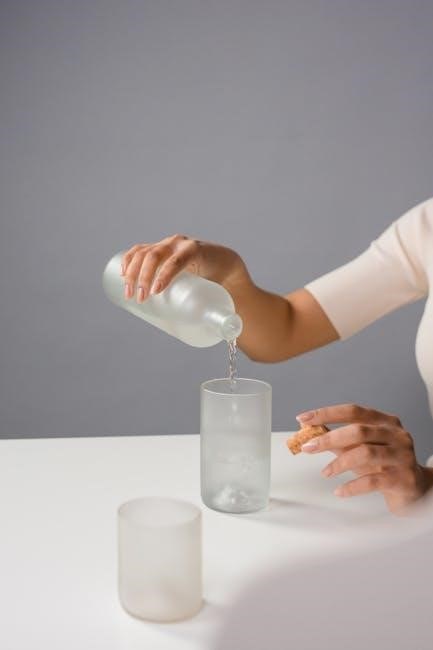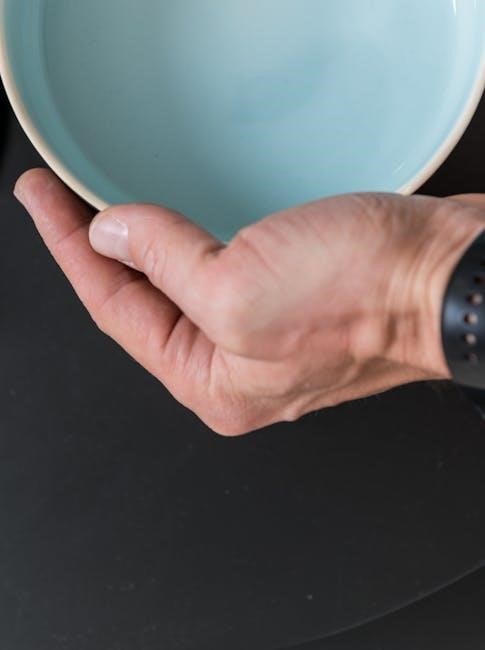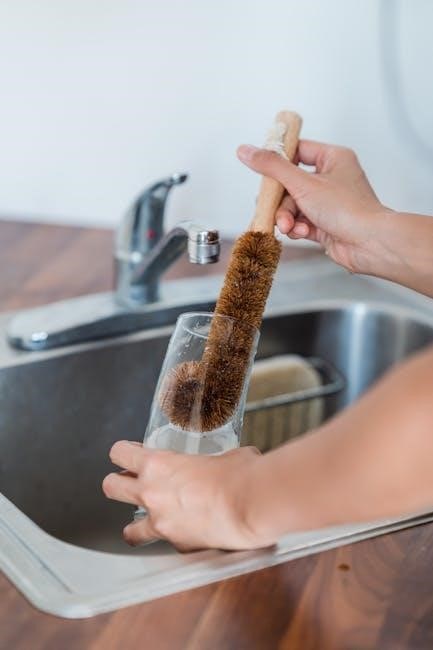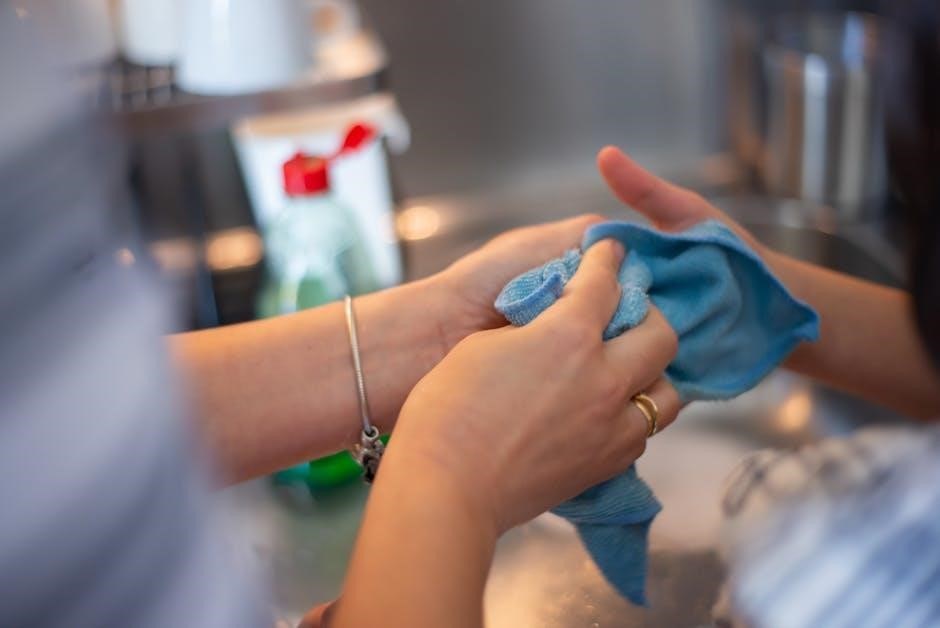Safety Precautions
Always read and understand this manual and safety messages before installing or operating the AO Smith water heater to prevent injuries and ensure proper functioning․
1․1․ General Safety Precautions
- Always read and understand this manual and safety messages before installing or operating the AO Smith water heater․
- Ensure the water heater is installed, maintained, and serviced by a qualified professional to prevent injuries or property damage;
- Keep flammable materials away from the water heater to avoid fire hazards․
- Operate the Temperature and Pressure Relief Valve annually and inspect it every 2-4 years as recommended․
- Ensure proper ventilation in the installation area to prevent the accumulation of hazardous fumes․
- Never modify or tamper with the water heater’s components, as this can lead to malfunction or safety risks;
- Keep children away from the water heater to avoid accidental injuries․
Following these precautions ensures safe and efficient operation of your AO Smith water heater․
1․2․ Hazard Warnings and Cautions
Heed all hazard warnings and cautions to prevent injuries, property damage, or voiding the warranty․ Scalding risk: Water temperatures above 120°F can cause severe burns․ Set the temperature below 120°F for safety․ Improper installation can lead to gas or carbon monoxide leaks, posing serious health risks․ Only licensed professionals should install or service the unit․ Never modify or tamper with the water heater’s components, as this can result in malfunction or safety hazards․ Risk of electrical shock exists if the unit is not properly grounded․ Always follow local codes and manufacturer instructions․ Failure to inspect and maintain the Temperature and Pressure Relief Valve can lead to catastrophic failure․ Ignoring these warnings may result in severe injury or death․ Always prioritize safety when operating or servicing the AO Smith water heater․
1․3․ Temperature and Pressure Relief Valve Maintenance
Regular maintenance of the Temperature and Pressure (T&P) Relief Valve is crucial for safe operation․ Annually operate the valve to ensure proper function and prevent corrosion buildup․ Inspect the valve every 2-4 years or as indicated by the manufacturer․ If the valve shows signs of leakage, damage, or corrosion, replace it immediately․ Always follow the manufacturer’s instructions for testing and replacing the T&P valve․ Ensure the valve is properly installed and directed to a safe drain to avoid scalding water discharge․ Failure to maintain the T&P valve can lead to excessive pressure buildup, resulting in potential tank rupture or safety hazards․ Always adhere to local plumbing codes and AO Smith recommendations for optimal performance and safety․

Installation Guidelines
Ensure installation complies with local codes and manufacturer instructions․ Provide proper ventilation, ensure correct electrical and plumbing connections, and secure the unit to prevent movement or damage․
2․1․ Installation Requirements and Location
Install the AO Smith water heater in a well-ventilated area, ensuring compliance with local building codes and regulations․ The unit must be placed on a level surface, preferably in a drain pan to prevent water damage․ Avoid installing in unventilated or confined spaces to prevent gas buildup․ Ensure proper clearance from flammable materials and keep the area around the heater clear of obstructions․ The location should provide easy access for maintenance and servicing․ Do not install in areas exposed to direct sunlight, extreme temperatures, or near flammable materials․ Always follow the manufacturer’s guidelines for specific location requirements and consult local authorities for additional regulations․
2․2․ Venting and Clearance Instructions
Ensure proper venting to prevent carbon monoxide buildup․ Use a Category III or IV venting system as specified in the AO Smith manual․ Maintain minimum clearances: 12 inches from windows, doors, or vents, and 6 inches from walls or other obstructions․ Horizontal venting requires a rise of at least 1/4 inch per foot to ensure proper draft․ Avoid installing vents near flammable materials or in confined spaces․ Follow local building codes and manufacturer guidelines for venting configurations․ Keep the area around the vent clear of debris to ensure safe operation․ Proper venting and clearance are critical for safety, efficiency, and compliance with regulations․ Always consult the manual for specific venting requirements based on your unit’s model and fuel type․
2․3․ Electrical and Plumbing Connections
Ensure all electrical connections comply with local codes and the AO Smith manual․ Hire a licensed electrician for installations requiring 240-volt service․ Use copper or PEX tubing for water lines, avoiding PVC due to heat risks․ Install a dedicated 20-amp circuit breaker for electric models․ For gas models, connect the gas line securely, ensuring no leaks․ The temperature and pressure relief valve must be properly connected to a drain․ Ground the unit as specified to prevent electrical hazards․ Follow the manual’s wiring diagrams for accurate connections․ Double-check all plumbing fittings for tightness to avoid leaks․ Ensure the water heater is level to maintain proper function․ Always test electrical and plumbing connections before initial startup to ensure safety and efficiency․

Operating Instructions
Follow the manual for initial start-up, adjusting temperature settings, and energy-efficient operation․ Ensure proper function by adhering to guidelines for safe and optimal water heater performance․
3․1․ Initial Start-Up and Setup
Before operating your AO Smith water heater, ensure all electrical and plumbing connections are secure and meet local codes․ Read the manual thoroughly to understand safety guidelines and operating instructions․ Check the temperature and pressure relief valve to ensure it is functioning correctly․ Set the temperature to the recommended level, typically between 120°F and 140°F, to balance efficiency and safety․ Turn on the power and allow the heater to fill with water․ Once filled, check for leaks and ensure proper operation․ Refer to the manual for model-specific instructions, as settings may vary․ Proper initial setup ensures safe and efficient performance․ Always follow manufacturer guidelines to avoid potential hazards and maintain optimal functionality․
3․2․ Adjusting Temperature Settings
To adjust the temperature on your AO Smith water heater, locate the thermostat on the control panel․ Set the desired temperature between 120°F and 140°F for optimal safety and efficiency․ Higher settings may increase energy costs and risk of scalding, while lower settings can reduce energy consumption․ Use the provided instructions in the manual for specific adjustment steps, as controls may vary by model․ Always allow time for the heater to reach the new temperature before checking for accuracy․ Regularly review and adjust settings to match your household needs․ Proper temperature management ensures comfort, safety, and energy efficiency․ Refer to the manual for detailed guidance on temperature calibration and maintenance․
3․3․ Energy Efficiency and Usage Tips
To maximize energy efficiency with your AO Smith water heater, consider lowering the temperature setting to 120°F, which reduces energy consumption while maintaining sufficient water heat․ Regularly inspecting and maintaining the heater, such as checking insulation and ensuring proper venting, can improve efficiency․ Install a timer or use the built-in energy-saving mode to operate the heater only during peak usage hours․ Insulate exposed hot water pipes to minimize heat loss․ For added efficiency, consider upgrading to an AO Smith high-efficiency model with advanced features like heat pumps or smart controls․ These tips can help lower energy costs and extend the lifespan of your water heater while reducing environmental impact․ Always refer to the manual for model-specific energy-saving recommendations․

Maintenance and Care
Regularly inspect the AO Smith water heater for leaks, corrosion, and proper ventilation․ Flush sediment annually to maintain efficiency and extend lifespan․ Ensure the T&P valve operates correctly․
4․1․ Routine Maintenance Tasks
Perform routine maintenance tasks to ensure the AO Smith water heater operates efficiently and safely․ Check for leaks around connections and inspect the anode rod annually to prevent corrosion․ Flush sediment from the tank every 6-12 months to maintain performance and longevity; Ensure proper ventilation by checking vents and combustion air openings for blockages․ Regularly inspect the temperature and pressure relief valve to confirm it operates correctly․ Clean the exterior and surrounding area to avoid dust buildup․ Refer to the manual for specific instructions on these tasks to avoid voiding the warranty․ Always turn off power and water supply before performing any maintenance to ensure safety․
4․2․ Inspecting and Replacing Parts
Regularly inspect the AO Smith water heater’s components to ensure optimal performance․ Check the anode rod for corrosion and replace it every 3-5 years or as needed․ Inspect the temperature and pressure relief valve for proper function and replace it if it shows signs of wear․ Examine heating elements and electrical connections for damage or corrosion, replacing them if necessary․ Refer to the manual for part numbers and replacement instructions․ Always shut off power and water supply before performing inspections or replacements․ If unsure about any procedure, consult a licensed professional․ Keep a record of inspections and replacements to maintain warranty validity and ensure long-term efficiency of the water heater․
4․3․ Anode Rod Replacement and Inspection
The anode rod in your AO Smith water heater plays a critical role in protecting the tank from corrosion․ Inspect the anode rod every 3-5 years or as recommended in the manual․ To inspect, drain the tank partially, remove the rod, and check for significant corrosion or depletion․ If the rod is heavily corroded, replace it immediately to prevent tank damage․ Use a magnesium anode for better protection․ When replacing, ensure the new rod matches the specifications in the manual․ Always shut off power and water supply before performing any work․ If unsure, consult a licensed professional․ Regular inspection and replacement of the anode rod will extend the lifespan of your water heater and maintain its efficiency․

Troubleshooting Common Issues
Identify common problems like error codes, leaks, or temperature issues․ Check the manual for specific solutions and perform basic checks before calling a professional for assistance․
5․1․ Identifying Common Problems
Common issues with AO Smith water heaters include leaks, insufficient hot water, and error codes․ Check for visible water leaks around connections and valves․ If the water temperature is too low, ensure the thermostat is set correctly․ Error codes on the display indicate specific problems, such as faulty sensors or heating elements․ Refer to the manual for code meanings and troubleshooting steps․ Annual maintenance, like checking the T&P valve, can prevent many issues․ If problems persist, consult the troubleshooting guide or contact a licensed technician․ Always follow safety precautions when addressing any malfunction to avoid injury or further damage․
5․2․ Understanding Error Codes
AO Smith water heaters display error codes to indicate specific issues․ Codes like “E01” or “E02” typically relate to sensor malfunctions or heating element problems․ Refer to the manual for a detailed list of codes and their meanings․ For example,temperature sensor faults or power supply issues may trigger these codes․ If an error appears, switch off the heater and consult the troubleshooting section․ Some codes require professional assistance, while others may be resolved by resetting the unit or checking connections․ Always follow safety guidelines when addressing errors to avoid further damage or injury․ Regular maintenance can help prevent many issues, but if a code persists, contact a licensed technician for assistance․
5․3․ DIY Repair Solutions
For AO Smith water heaters, some issues can be resolved with basic DIY repairs․ Start by checking the power supply and ensuring the circuit breaker isn’t tripped․ If the heater isn’t heating, verify the thermostat settings․ For leaks, inspect connections and tighten any loose fittings․ If the temperature and pressure relief valve is discharging, check for excessive pressure or temperature․ Descale the heater periodically to remove mineral buildup․ Replace the anode rod if corroded to prevent tank damage․ Always turn off power and water supply before attempting repairs․ Refer to the manual for specific guidance․ If unsure, consult a licensed professional to avoid further damage or safety risks․ Regular maintenance can prevent many common issues․
